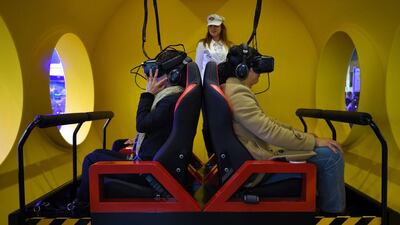Virtual reality (VR) is facing significant obstacles in its quest for acceptance in actual reality, if the latest moves by Oculus VR are any indication.
The Facebook-owned company last week announced a sale on the Oculus Rift bundle, its second price drop in four months. The headset and handheld controllers are now going for US$399, down from the regular price of $598, which itself was a cut from $798. All told, the bundle is now selling for half its price in March.
Additionally, Oculus is planning a new wireless headset for next year that will sell for $200 and will not need to be attached to a computer, according to a Bloomberg report.
The new device, code-named Pacific, will be lighter than existing smartphone-driven headsets such as Samsung's Gear VR, but also more powerful. It will have a handheld controller but its lack of connection to a computer means it also will not have spatial tracking, which is what gives users a true sense of presence within virtual environments, according to the report.
Oculus’ plans, if they are true, are all well and good but they are not likely to spur VR’s popularity with mainstream buyers in the near term. VR, although impressive, has a long way to go before it is ready for prime-time.
The technology has a laundry list of problems to overcome. Price has been a big barrier so far for Oculus and its main high-end competitor, the $799 HTC Vive. It is perhaps the main reason why the two have sold fewer than a million units combined, according to several estimates.
The need for a powerful computer to drive the experience also means the consumer’s entry cost is typically in the thousands of dollars on top of the headsets themselves. Add in the cable that leashes the user to a computer and it is no surprise that only early-adopters have bitten so far.
Lowering the cost and eliminating the cable and computer, as Oculus is reportedly doing, are necessary steps - but it remains to be seen whether the company can pull off something superior to what sounds a lot like the existing mobile VR.
Smartphone-powered devices such as Samsung’s Gear VR have done comparatively better. Samsung says it has shipped more than 5 million units, although those numbers are probably inflated since many were free throw-ins with smartphone purchases.
Software sales are a better indicator of the public’s interest in mobile VR, and the story there is not good either. Many apps for Google’s Daydream VR headset, for example, have been downloaded fewer than 5,000 times. Developers are understandably wary of expending their time and resources for such small returns.
Sony has had some success with its PlayStation VR, selling a reported million units, largely because it has mitigated some of the technology’s problems. Its headset provides a more immersive experience than mobile VR and is only slightly less powerful than the Rift and Vive, but it is also considerably cheaper at $399. It also does not require an expensive computer to power it, just a PlayStation 4 console, which many gamers already own.
Still, Sony’s problem is that its own gaming competitors - Microsoft and Nintendo - have failed to legitimise VR. Microsoft is instead focusing on more limited augmented reality with its HoloLens headset, while Nintendo looks to be staying away entirely.
The results on all three forms of the platform - high-end, mobile and game console - is that there has yet to be “killer app", a game or other piece of software that sells in big numbers and kick-starts the public’s imagination.
VR is thus settling into its own chicken-or-the-egg phase. Consumers are not going to buy into it without the killer app, but there aren’t enough developers working at creating one because the existing customer base is too small.
There is no guarantee of either the chicken or the egg arriving. Quite the opposite - VR has one more major problem with no foreseeable, near-term solution: movement within environments.
So far, every VR headset requires its wearer to use a handheld controller to move around, which is at odds with how people actually go from place to place in the real world. Using our hands to move our feet is counter-intuitive and does much to ruin VR’s immersion. Until this problem is solved, virtual reality is really more like virtual virtual reality.
Some third-parties are working on treadmills that VR headset wearers can walk on, but that is not a viable answer. Again, early-adopters might go for it but few mainstream consumers are going to want to install such bulky and expensive contraptions in their homes.
VR'S future may, thus, depend on some irony. While VR itself was once considered a futuristic technology, it may need to wait for another seemingly far-off development - like a brain interface that can trick its user into truly feeling the virtual movement - to become reality before it can take off.
There is not much that Oculus or anyone else can do about that besides wait.
Peter Nowak is a veteran technology writer and the author of Humans 3.0: The Upgrading of the Species

